Doomed love and desperation
inevitably drive many of the operatic protagonists to commit tragic acts, but,
alleviating the despair, one man’s determination to be married results in a
mad-cap dash around Paris in search of a Florentine straw hat.
The real ‘find’ of this Festival is undoubtedly Jacopo Foroni’s
Cristina, Regina di Svezia, (seen on 25th October) first
performed in 1849 and rarely heard since. Foroni was of Veronese birth but
spent most of his working life in Sweden, introducing the Swedes to the latest
works by Bellini, Donizetti and Verdi, before his own untimely death in 1849
during a cholera epidemic. On the evidence offered by Stephen Medcalf’s
outstanding production of Cristina, Foroni was just as blessed with
melodic and orchestrational gifts as were his better-known Italian compatriots.
Cristina was presumably intended to endear him to audiences in his
newly chosen land. Set in the Tre Kronor castle in Stockholm, the opera
presents the historic events leading to the abdication of Queen Cristina of
Sweden in 1654, and depicts a knotted web of unrequited and frustrated love.
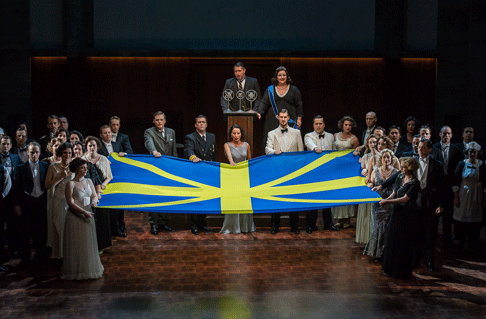 Cast of Cristina, regina di Svezia
Cast of Cristina, regina di Svezia
The Lord High Chancellor, Axel Oxenstjerna, accompanied by his son, Erik,
has brokered a peace treaty to end the Thirty Years’ War, and at a public
celebration of peace, Cristina rewards her loyal servant by announcing that
Erik is to be given the hand of Maria Eufrosina, the Queen’s cousin, in
marriage. Maria and her beloved Gabriele de la Gardie are less than delighted
with this arrangement, but when Gabriele, who is himself the object of the
Queen’s affections, suggests that they should elope, Maria desists, reminding
Gabriele of the loss of honour that such an act would occasion. Maria’s
hopeless weeping is interrupted by the Queen’s arrival; despatching Maria
before the latter can explain the cause of her tears, Cristina then tells
Gabriele of her hopes that they can rules Sweden together; she is unaware that
Arnold Messenius and his son, Johan, are secretly plotting to overthrow her.
At the wedding, Maria is unable to go through with the ceremony and
confesses that she loves another; when pressured by the Queen, she identifies
her beloved as Gabriele. Furious, Cristina vows that Gabriele will be exiled;
Messenius and his son now hope to recruit Gabriele to their seditious cause.
Meanwhile, Carlo Gustavo, Cristina’s cousin and the heir to the throne,
has heard of the planned treachery and arrives on the island of ÷land to
infiltrate the conspirators, who now include Gabriele. Axel urges Cristina to
accept Gustavo’s love and rule with him, but the Queen has become despondent
and tells Axel of her wish to renounce the throne. When the rebels storm the
castle, Gustavo declares that he will defend Cristina; subsequently, Gabriele,
Messenius and Johan, are brought before Cristina who condemns the traitors,
including Gabriele, to death. She tells Gustavo of her plan to abdicate in his
favour and live the rest of her life in Italy; he tries to discourage her, and
of his wish that they should marry and rule together, but she is adamant.
In the Grand Council chamber, the intriguers are sentenced, but as they are
led away to their execution Cristina enters and publically forgives Gabriele,
declaring that he may now marry Maria. She announces her own abdication, and
places the crown on the reluctant Gustavo’s head. The people swear allegiance
to their new monarch.
The life of the real Cristina was certainly filled with events of operatic
proportions: thrust into public office from a tender age, following the death
in battle of her father, Gustavus Adolphus II, when she was just six years old,
she was a strong monarch but an unconventional one. By no means a beauty, and
with a hunger for culture and learning considered ‘unfeminine’ during this
period, she was stubbornly nonconformist; she refused to marry, dressed in a
masculine fashion and indulged her interests in religion, alchemy and science.
When she abdicated in 1654 she stunned her country by renouncing her father’s
Lutheran faith and converting to Catholicism; however, Cristina did not lose
her appetite for power and prestige, attempting to become Queen of Naples in
1656 (she made sure that the man who betrayed her plans was executed), and
later seeking the Polish throne.
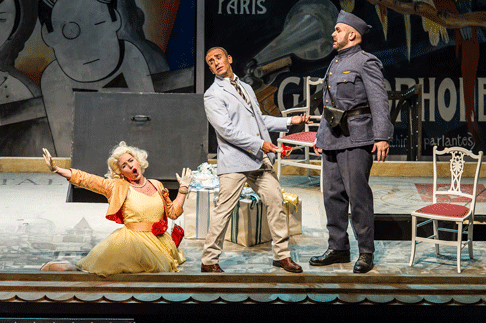 Eleanor Lyons, Fillipo Adami and Owen Gilhooly in Il Cappello di paglia di Firenzie
Eleanor Lyons, Fillipo Adami and Owen Gilhooly in Il Cappello di paglia di Firenzie
Foroni’s Cristina is less petulant and extreme – the unruly hair,
men’s shoes and epicurean habits are not in evidence – and the focus of
Giovanni Carlo Casanova’s libretto is on the loneliness which arises from the
burdens of public duty. Indeed, the principals all suffer this inner tussle
between personal fulfilment and honourable obligations; thus, during the
opening moments of the overture, the passionate embrace of Maria (Lucia
Cirillo) and Gabriele (John Bellemer) is interrupted by the arrival of stern
officials, and all stiffly assume their places upon imposingly straight-backed
Rennie Mackintosh chairs, facing the screen that will shortly announce the
momentous political events. Medcalf and his designer, Jamie Vartan, have
transferred the action to London during the 1930s, a time when such emotional
conflicts would certainly have been recognised by a nation whose monarch had
recently put love before duty, thrusting a reluctant sibling onto the throne.
Film sequences during the opening act effectively showcase the parallels.
First we have Neville Chamberlain waving the Munich Agreement before grateful
crowds; then, reversing the historical chronology, the coronation of George VI.
The decision to replace seventeenth-century Swedish court life with a more
familiar era, and one characterised by formality and decorum, also allows for
some superb tableaux – and for some striking Downton Abbey-style costumes.
Thus, the curtain rises on an impressively attired chorus of noblemen,
soldiers, officials and servants, frozen for the briefest moment before the
whirling celebration of peace ensues. Similarly cinematic effects are
strikingly deployed in the wedding scene where Maria’s emotional
disintegration is charted by a series of flash bulb freeze-frames which
shockingly capture her growing despair. Only the archive film of bombing raid
fires, shown in the moments preceding the storming of the castle, seemed a
little too lengthy.
Vartan’s sets are engaging and ingenuous. After the imperious ceremony of
the opening scenes, Act 2 finds Cristina in her private chambers, reflecting on
the futility and destructiveness of power, and the art deco panelling,
furniture and globe economically whisk us to a 1930s interior. Later, as she
determines her future, and that of her nation, we see the Queen seated in her
office, raised aloft, thereby emphasising her distance from her subjects and
her emotional isolation.
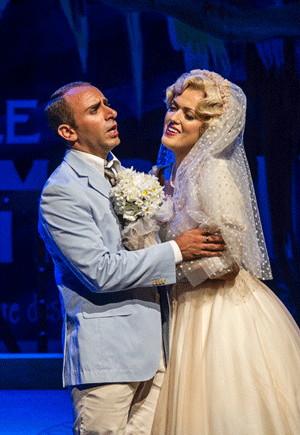 Claudia Boyle and Fillipo Adami in Il Cappello di paglia di Firenze
Claudia Boyle and Fillipo Adami in Il Cappello di paglia di Firenze
In many years of visiting Wexford, I don’t think I have ever heard the
Wexford Festival Chorus sound better; Foroni’s choruses combine Verdian
vigour with occasional contrapuntal complexity, and the massed voices were on
top form, producing a rich Italianate tone and singing with total commitment.
Paula O’Reilly’s choreography is excellent, making full use of the stage,
and the numerous personnel moved with fluency and naturalness. The arrival of
Gustavo at the start of Act 2, his parachute descent wittily foreshadowed by
some historical war footage, is a masterstroke which drew a gasp of praise.
Moreover, the brooding red haze of Paul Keogan’s lighting design throughout
the conspirators’ scene looks ahead ominously to the rebellious invasion of
the Queen’s castle.
Foroni offers the singers some wonderful cantabile melodies and the cast
relished them. As Maria, mezzo soprano Lucia Cirillo displayed a sumptuous tone
and crafted beautifully balanced phrases. John Bellemer, who impressed as Sali
in Medcalf’s production of A Village Romeo and Juliet at last
year’s Festival, was similarly convincing as the impetuous, fervent Gabriele;
as he sang of his love for Maria, his tenor was focused and intense, full of
drama and feeling. Russian baritone, Igor Golovatenko was a strong Gustavo,
resonantly exhibiting his love and loyalty for his Queen. (I had a small
misgiving about the final tableau, however; would the steadfast Gustavo,
however reluctantly endowed with royalty, immediately overturn Cristina’s
last act of clemency and execute the pardoned conspirators – who had, after
all, wished to promote Gustavo himself to the throne?)
Bass Thomas Faulkner and tenor Daniel Szeili acquitted themselves well as
Messenius father and son respectively; Szeili displayed a tenor voice of great
tenderness in a final aria of remorse which was truly moving. As Erik, Irish
tenor Patrick Hyland showed great promise. David Stout’s Axel was
particularly impressive during his Act 2 interview with Cristina, his
well-rounded bass-baritone earnestly pleading with his Queen to marry Gustavo
and remain monarch.
In the title role, Australian soprano Helena Dix demonstrated enormous
stamina and impressive vocal power and accuracy. Dix has a silky lyric tone and
she soared effortlessly in the large choral scenes. But, while her voice has
much nobility and poise, I felt that Dix would have benefited from greater
direction, for her posture and movements were not always sufficiently
‘regal’; she presided with formality and pomp during the public ceremonial
scenes, but was less persuasive during the more personal interactions with her
subjects. Dix’s costumes did not help imbue her with imperial majesty. When
all around her were attired in elegant evening dress or impeccable uniforms,
the Queen was initially robed in a black tent-like gown reminiscent of Queen
Victoria’s mourning attire topped off with a blue sash, rather like a pageant
princess. Even allowing for insomnia and workaholic restlessness, it is surely
unlikely that Cristina would conduct her private meetings in silk pyjamas? And,
in the final Act, her dull brown fitted suit and Hartmann suitcase suggested
that the Queen had fallen far following her abjuration of the throne. A pity,
when there were copious visual delights all around her, and Dix’s own singing
won her a greatly deserved ovation.
Conductor Andrew Greenwood had the full measure of the score, ensuring that
Foroni’s varied orchestral colours were clearly heard and appreciated, and
shaping the surges and lulls with passion and perceptiveness.
With such riches on offer, one wonders why Cristina was not more of
a hit? Presumably the Swedes were none too thrilled to be reminded of a monarch
who had rejected her people and their faith, while it seems the Italians did
not take to Cristina all that warmly either. Hopefully this convincing,
imaginative Wexford’s production will put an end to the unjust neglect that
Foroni’s terrific opera has endured.
Desire and duty did battle once more in a double bill (27th
October) which reminded us of Jules Massenet’s skills as a melodist and also
revealed a starker, more brutal idiom than we might expect from this most
lyrical of composers.
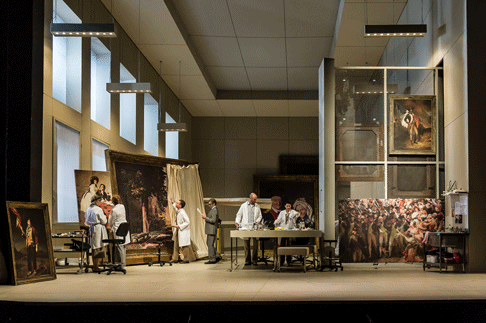 Scene from ThÈrËse
Scene from ThÈrËse
Set in Revolutionary France, during the Terror of 1793-94,
ThÈrËse (1907) is a melodrama which pits public against private,
loyalty against love. As with Foroni’s Cristina, the eponymous
heroine is based on a historical figure, in this case, Lucille Desmoulins who
was executed in 1793, eight days after her husband, Camille. In Jules
Claretie’s libretto, ThÈrËse finds herself torn between her allegiance to
her husband, AndrÈ Thorel – a Girondist and man of the people – and her
passion for her aristocratic lover, Armand, Marquis de Clerval, who has fled to
escape the Revolution. Thorel, the former childhood companion of Armand (his
father was the Marquis’ steward), has purchased the Clerval chateau in order
that it may one day be returned to his friend. When Armand reappears, still
deeply in love with ThÈrËse, she is torn between her amorous feelings and her
fidelity to her marriage vows.
AndrÈ offers Armand protection within the chateau, and then provides him
with a letter of safe passage so that he can escape the revolutionary horror.
Emotions rise both in the house and on the streets, and Armand realises that he
must leave. As her husband fights at the barricades with the Girondists,
ThÈrËse initially agrees to flee with Armand, but on hearing that AndrÈ has
been captured and is to be executed, she recognises her true duty and cries,
‘Vive la roi!’ Arrested by the incensed Revolutionaries, she is taken to
the guillotine, to die by her husband’s side.
In true verismo fashion, the plot is taut and intense: the
conflicts are clearly drawn, the emotions pure and deep. The Director-Designer
team of Renaud Doucet and AndrÈ Barbe offer a marked twist though: we enter
the eighteenth-century revolutionary world through a painterly frame, as
curators and conservators in a starkly lit museum restoration workshop,
scientifically preserve and renovate ‘the past’ as depicted by the works of
art. ‘Stepping out’ of the paintings, the figures from history re-live
their former experiences, their desperate emotions and suffering presenting a
destabilising contrast to the clinical detachment of the modern scholars as
they go about their task of historical reconstruction and repair. This schism
between the emotional experience of those in the foreground and the cerebral
intellect of those glimpsed beyond is one of the strengths of the concept, and
it is enhanced by Paul Keoghan’s arresting lighting designs, the glacial cool
of the workshop strip-lights replaced, for example, by a nostalgic yellow glow
as Armand and ThÈrËse recollect their former love. Similarly, the vibrant
colours and luxurious fabrics of the eighteenth-century attire contrast
robustly with the clinical uniforms and workday attire of the present.
Yet, there are aspects of the staging that are less effective. The
interactions between the figures from the past and present at the start of the
opera are somewhat confusing and, having immersed ourselves in ThÈrËse’s
fate it is disconcerting to be yanked back to the present when she is carried
off to the scaffold not by the Revolutionaries but by technicians in white lab
coats. Barbe and Doucet declare their intention to ‘explore the influence of
painting on life’, but ThÈrËse is about life, not art.
The strongest juxtaposition in the opera is between the inner life of the
private heart and the external world of public politics and strife; it is an
opposition which is embedded in the score and one which this production does
not make sufficiently evident.
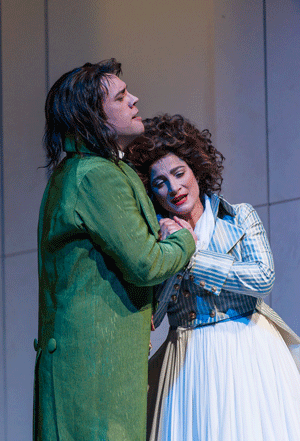 Brian Mulligan and Nora Sourouzian in ThÈrËse
Brian Mulligan and Nora Sourouzian in ThÈrËse
At the heart of the score are the passionate exchanges of ThÈrËse and
Arnaud, and French-Canadian mezzo soprano Nora Sourouzian and French tenor
Philippe Do prove that they possess the stylishness, lyricism and sensitivity
to convey the poetry of these scenes most beautifully. Do has both the
strength, though the voice is never forced, to bring a fierce ardour to the
passionate high-points and a floating mezza voce which can modulate
the emotional fire with sensitivity and lightness. ThÈrËse’s Act 2 aria,
‘Jour de juin, jour d’ÈtÈ’ was deliciously sweet and exquisitely
phrased. Brian Mulligan, as AndrÈ, made a considerable impact, demonstrating
fine stage presence and singing with an open, burnished tone. Damien Pass was
very competent in the small role of Morel.
The four principals showed their fortitude and versatility when they
returned for the second half of the double bill: La Navarraise,
another opera in which the personal and political intertwine, and one which at
times seems more characteristic of Mascagni than Massenet.
First performed at Covent Garden in June 1894, La Navarraise is
based on a short story,La Cigarette, by Claretie, which the author
adapted, in collaboration with Henri Cain. Anita, a poor girl from Navarre, and
Araquil, a soldier in the Spanish civil war, are in love but are forbidden to
marry by Remigio, Araquil’s wealthy father, unless Anita pays a dowry of two
thousand duros. The commander Garrido learns that his friend has been killed by
the enemy commander, Zuccaraga, and declares his hatred for the latter; Anita
proposes that she will kill Zuccaraga for a sum of two thousand duros, and
although he is suspicious of her motives, Garrido agrees. As she approaches the
enemy camp, protected by her statue of the Virgin Mary, Anita is observed by
the soldier Ramon, who, assuming that Anita is a spy, tells Araquil; the latter
fears that she has is visiting a secret lover. Having killed Zuccaraga, Anita
runs through the gunfire and collects her reward from Garrido, who makes her
swear not tell anyone of her deed.
Araquil, who has been mortally wounded during his search for Anita, demands
to know where she has been, but her oath prevents her from speaking out and all
she can do is show him the money in the hope that the realisation that they can
now marry will quell his anger. Araquil, however, assumes she has prostituted
herself, which she vehemently denies. As Remigio arrives with a doctor to tend
his son, bells are heard in the distance, and Remigio explains that they are
tolling for the assassinated Zuccaraga. Finally understanding the truth,
Araquil dies. Anita becomes hysterical, wildly speaking of her forthcoming
marriage which she thinks the bells foretell. Desperately seeking a knife with
which to commit suicide, she realises that she lost it at the murder scene; all
she has is her statue of the Holy Virgin. Before the horrified onlookers she
erupts in crazed laughter and falls senseless, as Garrido laments ‘La
folie’, the poor mad child.
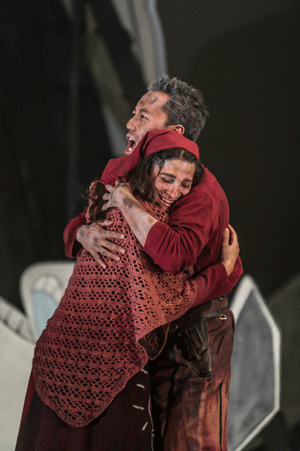 Nora Sourouzian and Phillipe Do in La Navarraise
Nora Sourouzian and Phillipe Do in La Navarraise
Doucet and Barbe once again filter the tale through art, transforming the
museum workshop to the Atelier des Grande-Augustins where Picasso painted
Guernica. Created in response to the bombing of Guernica, a Basque
village in northern Spain, by German and Italian warplanes at the behest of the
Spanish Nationalist forces in 1937 during the Spanish Civil War,
Guernica does indeed provide fitting visual frame for Massenet’s
opera, for both works show the violence and chaos of war, and the suffering
that it inflicts upon the innocent.
The stage is a collage of out-sized fragments from the painting: the
wide-eyed bull; the horse falling in agony, a spear in its side piercing a
gaping wound; a human skull and other dismembered body parts; a stigma; flames.
Above, the projection of a gilded eighteenth-century chandelier has been
replaced by a blazing light bulb in the shape of an evil eye.
The stage space is in fact so cluttered with these artistic fragments that
there is hardly room to move, and the personnel are confined to a narrow strip
at the front of the stage. The coral, dusty pink and cinnamon hues of the
costumes and lighting summon up the rugged mountainous terrain of the region,
but overall the ambience feels rather too static and confined.
The singing was, however, as committed as before the interval, with Do and
Sourouzian once more a formidable duo, as Araquil and La Navarraise.
Sourouzian’s lustrous high register was in evidence, in her Act 1 lament that
she will not be able to marry her beloved Araquil; and she had real presence in
the fiery outbursts which result in her mad demise. Do, too, showed his
resourcefulness, creating a sincere portrait of a man of great strengths and
all too human weaknesses; his final words, ‘the price of blood! how
horrible!’, as Araquil realises the terrible lengths to which Anita has gone
to secure his love, were chilling. Damien Pass was imposing as Remigio, while
Brian Mulligan was a credible Garrido.
In the pit, Carlos Izcaray conducted with control, verve and attention to
detail; the lyrical stream of melody – there was some lovely solo cello
playing – was complemented by timbral bite and dynamic punch.
The third of the Festival’s trio of offerings provided some light relief
from the afflictions of social responsibility and unfulfilled love. The Italian
composer, conductor, pianist and academic Nino Rota is best known for his film
scores, notably for the films of Fellini, Visconti, Zeffirelli, and for the
first two films of Francis Ford Coppola’s Godfather trilogy.
Extraordinarily prolific, in addition to his considerable body of film work,
Rota composed ballets, orchestral, choral and chamber works, and ten operas,
one of which, Il Cappello Di Paglia Di Firenze (1955), director Andrea
Cigni presents this year at Wexford (seen 26th October).
The libretto, adapted by Rota and his mother, Ernesta, from a vaudeville by
EugËne Labiche and Marc-Antoine-AmÈdÈe Michel, Un chapeau de paille
d’Italie, and which had been filmed in 1928, has a plot which makes the
last act of Figaro seem the epitome of clarity and good sense.
On the morning that Fadinard is to be married to Elena, his horse eats a
straw hat which belongs to a woman who has evaded the jealous watch of her
vicious husband in order to rendezvous with her soldier lover. Confronted with
Anaide (distraught – she cannot return home without her hat) and Emilio (her
threatening and protective paramour), Fadinard realises he must find a
replacement hat, and so sets of on a zany chase across Paris on a mad hatter
treasure hunt, dragging deaf uncle, bumptious father-in-law, Nonancourt, and
troupe of inebriated wedding guests behind him. Sent by the milliner to the
Baronessa di Champigny’s residence, he is mistaken for a violin virtuoso; the
Baroness has given the hat to her friend, the wife of Beaupertuis – Anaide –
and so, unwittingly, Fadinard is thrown into the enemy’s den. While it rains
champagne, the wedding partygoers are happy to party where their dancing shoes
whisk them; but when it really rains misery sets in, especially when
they are arrested for trespass.
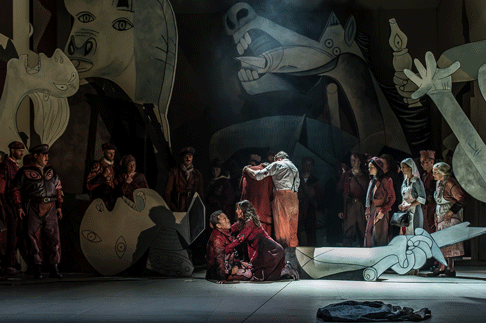 Scene from La Navarraise
Scene from La Navarraise
Just when all seems lost – when faced with a cancelled marriage, a
husband’s pistol and a prison cell – Fadinand is saved by deaf uncle
VÈzinet’s announcement that his wedding give is a Florentine straw hat –
the perfect substitute for Elena’s chomped bonnet, and just what is needed to
convince Beaupertuis that she is a wrongly accused innocent. The wedding of
Fadinand and Elena can go ahead – and we hope that their future matrimony is
not marred by further millinery machinations.
Director Andrea Cigni and Designer Lorenzo Cut˘li present us with a
front-drop carte postale dated 18th September 1958 which
when raised reveals a sloped postage stamp stage, embraced by an assemblage of
film and theatre posters which reference aspects of the farce to come:
Halle Chapeaux, L’InfidËle by Sheridan and Scott,
Chansons sous la pluie, Follies, High Society,
Gaines’ Scandale, Revel: Parapluie. All very eye-catching
but not much assistance in creating actual locales for the itinerant hat
hunters.
Rota’s score is pure opera buffa – referencing the originals,
Rossini and Donizetti, and throwing some sardonic twentieth-century spice
‡ la Prokofiev and Stravinsky. Musical quotations and self-quotations
abound, the orchestration is sassy, and it all zips along frothily if rather
superficially – indeed, one feels that a lot of rhythmic energy is expended
with little forward motion.
The problem with this production is that in aiming to make us laugh through
caricature, exaggeration and improbability, Cigni gets bogged down in
stylisation and extravagance, and things grind to a halt. The tilted stage
platform, while allowing for the suggestion of different floors within
Fadinand’s house, doesn’t help matters: the slick physical interchanges
that farce requires are simply not possible when the chorus is trying to dance
on a postage stamp, or principals are negotiating awkward trapdoors. To
compensate for the actual lack of physical movement, we have flashing
lights and outsized platters of fruit and cupcakes, but this is not sufficient
reparation for the lack of a real belly laugh.
That said, Cigni does effectively convey the sense of movement around the
city, but he has to take the chorus off the stage and deposit them in the
aisles to do so … the rain-soaked, champagne-sozzled revellers made a pitiful
trek through the auditorium, prior to the incarceration which would end their
carousing. The female chorus excelled, both as hat-sewing seamstresses and
resilient socialites.
Conductor Sergio Alapont failed to set things afire – though reliable,
there was a lack of lightness and vivacity in the pit – but the singers did
their best, although they did not look as if they were having much more fun
than we were. Stepping into Fadinand’s shoes at the eleventh hour, tenor
Filippo Adami revealed a clear, generous voice and a sure sense of comic
timing. Slight of stature, Adami possesses significant stage presence; he
played a noteworthy part in keeping the show rolling. His Elena, Irish soprano
Claudia Boyle, was all glittery insouciance, prepared to tolerate her groom’s
inexplicable goings-on with scarcely a complaint. Australian soprano Eleanor
Lyons sparkled with faux naivety as Anaide, while Owen Gilhooly made a strong
impression as Emilio, managing to be both menacing and sympathetic at the same
time.
In the cameo role of Uncle VÈzinet, tenor Aled Hall equipped himself well
and exhibited a warm baritone and much dramatic wit; Salvatore Salvaggio’s
Nonancourt was rather ponderous – his complaints about his pinching footwear
and repeated cries, ‘It’s all off!’, did little to hasten the action
forward. Filippo Fontana, as the bitter Beaupertuis, stayed the right side of
parody and his focused bass baritone brought some depth to the role; Turkish
mezzo soprano Asude Karayavuz enjoyed her turn as the outlandish Baronessa di
Champigny, exhibiting a full, rounded tone and endearing comic waggishness.
In addition to the three main house productions, Wexford offered its usual
diet of peripheral treats. Of the Short Works, Roberto Recchia’s
L’elisir d’amore (26th October) was the most ingenious,
transferring the action to a modern-day Irish Karaoke bar – one of the
virtues of which was to provide a naturalistic raison d’Ítre for
surtitles! The PR media show, complete with Twitter links, which accompanied
Dulcamara’s sales pitch was a scream – the only down side was that it
distracted from Thomas Faulkner’s accomplished singing. Jennifer Davis
relaxed into the role of Adina, singing accurately and with character; and
while Patrick Hyland may not yet have the Italianate silkiness which ‘Una
furtiva lagrima’ demands, his gentle, sensitive articulation was both
intelligent and touching. Ian Beadle was an ostentatious Belcore, and Hannah
Sawle produced an appealingly flirtatious lightness as Gianetta. After a
slightly weighty start, Musical Director Richard Barker kept things flying
along at the keyboard, although at over 90 minutes this was hardly a
‘short’ work.
In 2010, Richard Wargo’s Winners was staged in Wexford, and now
we had the opportunity to hear the second part of the musical adaptation of
Brian Friel’s two-parter, Losers. Set in the 1960s in the town of
Ballymore, County Tyrone, Losers is a deliciously wry send up of
religious fanatic fervour and the private destruction it wreaks – was it a
coincidence that the premiere (27th October) coincided with the
Festival Mass service …? Wargo employs an ear-pleasing idiom mingling
Bernstein-like lyricism, the fluency of popular song and Britten-esque timbres
(the women’s prayer recalls the soothing textures of the female quartet in
The Rape of Lucretia). As the frustrated Hanna Wilson-Tracy, whose
duty to mother and church must come before her natural affection for Andy Tracy
(Nicholas Morris), C·tia Moresco aroused pity and affection, her heart-warming
tone blending touchingly with Morris’s emotive baritone. Eleanor Lyons
displayed musical precision and dramatic wit as the oppressive matriarch, Mrs
Wilson; Kristin Finnegan and Chloe Morgan made up the fine cast, as the devout
Kate Cassidy and her rebellious daughter Cissy, respectively, in a production
which inspired mischievous laughs and resigned sighs alike.
Michael Balfe’s The Sleeping Queen was the most excitedly
anticipated but perhaps the least satisfying musically of the three Short
Works, despite the appealing designs of Sarah Bacon – all orange trees and
trellised patios – and the atmospheric lighting of Pip Walsh. There was some
fine singing from the young cast, not least from Johane Ansell as the Queen’s
maid, Maria Dolores, and tenor Ronan Busfield as the love interest, Philippe
D’Aguilar.
Lunchtime recitals in St Iglesias Church provided further musical
sustenance. On 25th October Asude Karayavuz, accompanied by Andrea
Grant, showed that she would make a fine Carmen, lustrous of tone and teasing
of demeanour. In two arias by Massenet she revealed a sultry lower register and
excellent French diction, later put to good use in Carmen’s Habanera
and Seguidilla. Karayavuz’ Mediterranean sensibility was tapped in
songs by Manuel de Falla, which she endowed with a folky silkiness and rueful
melancholy. Damien Pass roved far and wide on 26th October, from
Britten folk settings to authoritative readings of Vaughan Williams’
Songs of Travel, from Duparc’s settings of Baudelaire to
Waltzing Mathilda. Pass’s diction was exemplary, in whatever
language, and his tone striking – he is not afraid to indulge a whispered
piano and can spin a narrative thread most effectively.
Claire Seymour
Casts and production information:
Nino Rota: Il Capello Di Paglia Di Firenza
Fadinard, Filippo Adami; Nonancourt, SalvatoreSalvaggio; Beaupertuis,
Filippo Fontana; Lo zio VÈzinet, Aled Hall; Emilio, Owen Gilhooly; Felicelen,
Leonel Pinheiro; Elena, Claudia Boyle; Anaide, Eleanor Lyons; La Baronessa di
Champigny, Asude Karayavuz; Achille di Rosalba, Leonel Pinheiro; La modista,
Samantha Hay; Un caporale delle guardie, Nicholas Morris; Una guardia, Ronan
Busfield; Minardi, Feilmidh Nunan; Minardi’s Pianist, Richard Barker;
conductor, Sergio Alapont; director, Andrea Cigni; assistant director, Roberto
Catalano; designer, Lorenzo Cut˙li; lighting designer, Paul Keogan.
Jules Massenet: Il ThÈrËse
ThÈrËse, Nora Souzouzian; Armand de Clerval, Philippe Do; AndrÈ
Thorel Brian Mulligan; Morel, Damien Pass; Un Officier municipal, Jamie Rock;
Un Officer, Raffaele d’Ascanio; Un autre Officier, Padraic Rowan; Une Voix
d’Homme, Koji Terada; Une Voix de Femme, Christina Gill.
La Navarraise
Anita, Nora Sourouzian; Araquil, Philippe Do; Garrido,
Brian Mulligan; Remigio, Damien Pass; Ramon, Peter Davouren; Bustamente, Koji
Terada; Un Soldat, Joe Morgan. Conductor, Carlos Lzcaray; director, Renaud
Doucet; assistant director, Sophie Motley; designer, AndrÈ Barbe; lighting
designer, Paul Keogan.
Jacopi Foroni: Cristina
Cristina, Helena Dix; Maria Eufrosina, Lucia Cirillo; Axel
Oxenstjerna, David Stout; Erik Oxenstjerna, Patrick Hyland; Magnus Gabriel de
la Gardie, John Bellemer; Carlo Gustavo, Igor Golovatenko; Arnold Messenius,
Thomas Faulkner; Johan Messenius, Daniel Szeili; Un Pescatore, Joe Morgan; Voce
Interna, Hannah Sawle; conductor, Andrew Greenwood; director, Stephen Medcalf;
assistant director, Conor Hanratty; set designer, Jamie Vartan; lighting
director, Paul Keogan; choreographer, Paula O’Reilly.
Wexford Festival Opera, 23rd October – 3rd
November 2013
image=http://www.operatoday.com/Cristina_01.gif
image_description=Helena Dix as Cristina [Photo by Clive Barda]
product=yes
product_title=Wexford Festival 2013
product_by=A review by Claire Seymour
product_id=Above: Helena Dix as Cristina
Photos by Clive Barda